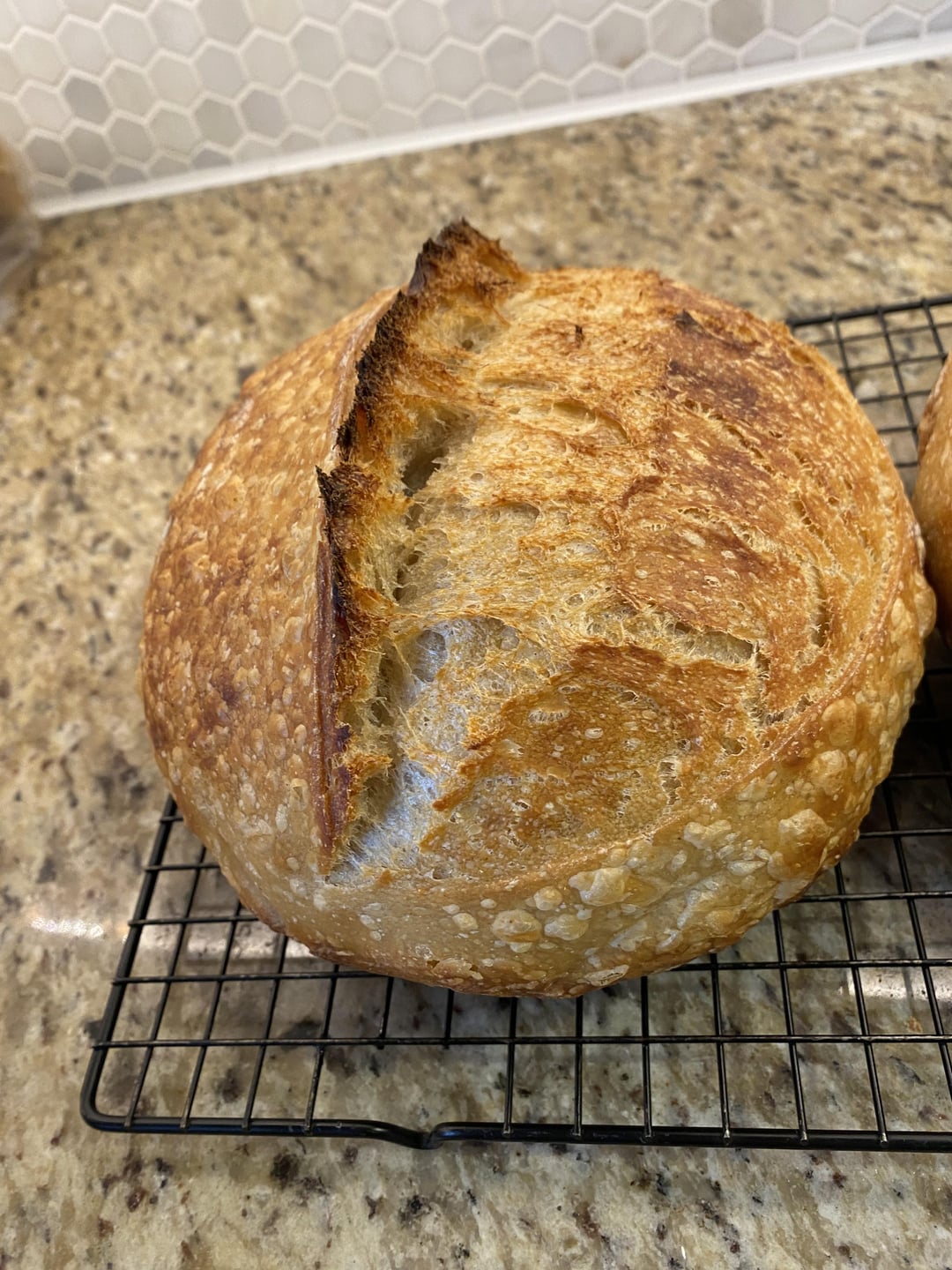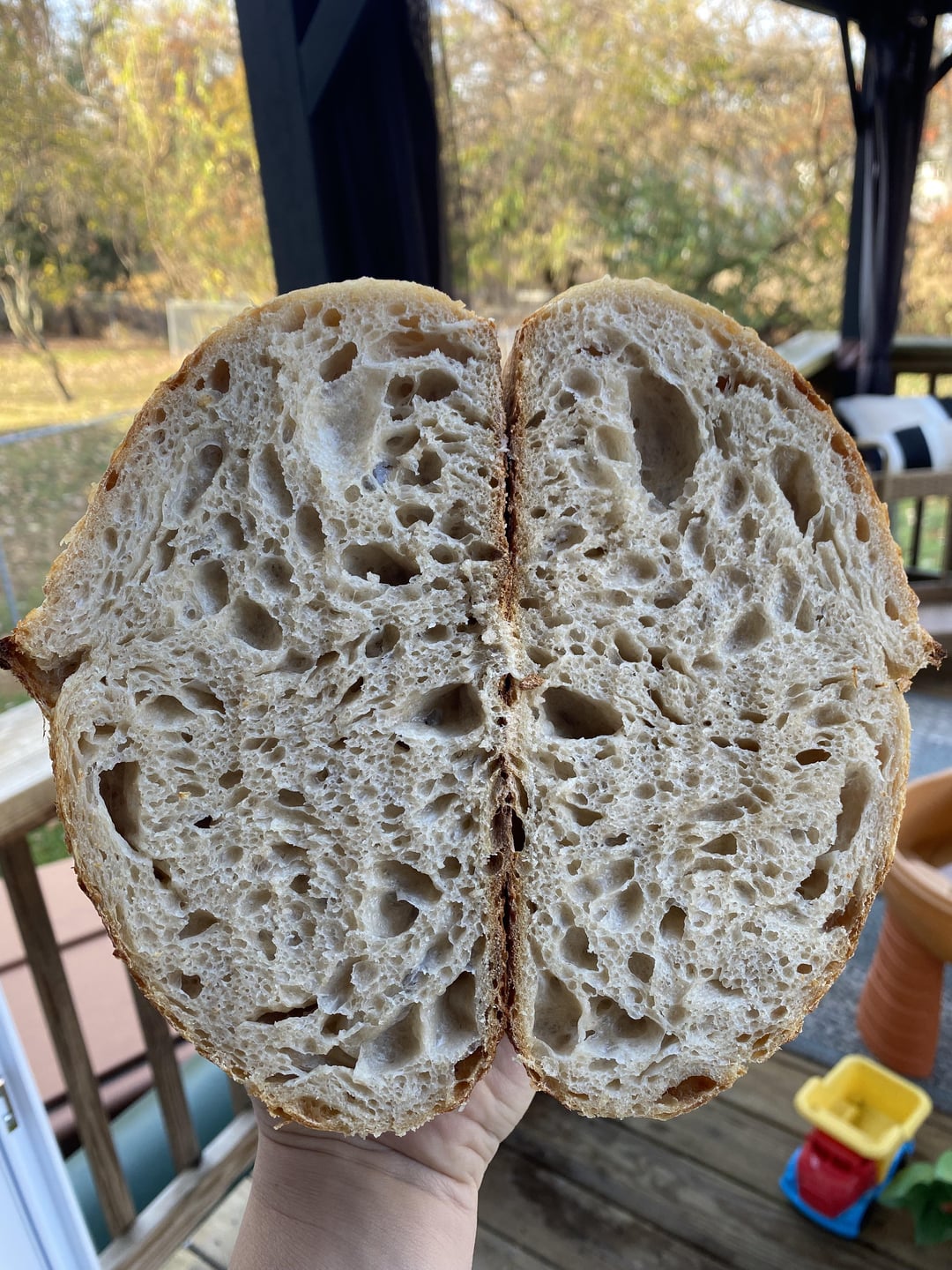



This is the tartine recipe other than my starter ratio that made two loaves:
800g KA bread flour
200g KA whole wheat flour
760g warm water ~90 degrees F
200g starter
20g salt
Mix all but salt and 30min autolyse
Add salt and execute pincer method and folds
Four sets of stretch and folds every 30 minutes and last two were coil folds
BF was about 5 hours
Preshape 30 min
Attempted to shape as batard and cold ferment for 10 hours in fridge overnight
Preheat Dutch oven at 500 degrees
Bake with lid 20 minutes
Bake without lid 20 minutes
I know this is a high hydration loaf, should I try lower hydration and work on shaping tighter? I’m assuming that’s why it’s turning into the Dutch oven shape because it comes out of the oval banneton basket as a batard. Chad’s seem to turn out as batards just fine, so I’m assuming this is technique. If anyone has a good batard shaping recommendation that would be appreciated!
Also, would like feedback on the crumb and if you think this is proofed properly. Thank you!
by Ok-Permission-9188

8 Comments
https://preview.redd.it/jpjveskmuhzd1.jpeg?width=3024&format=pjpg&auto=webp&s=41e4ec89801d968e855939a63f930ea5588266c1
This was the other loaf from the bake. This one had to go in a round banneton though so a little different outcome.
The crumb looks great! Seems like proofing was just right! I am yet to get there!
As for batard, you could try to make a log out of it (stretch into a rectangle, fold one third in and then the other third over the other two, and then to roll the whole thing into a tight log, stretching a bit for tension). But this is a different and simpler shaping technique that may be worse for your crumb than tartines method.
The Tartine book just shows boules being made in a cast iron combo cooker/double dutch oven. Is there a video where they are putting batards in a round dutch oven?
I had the same issue with batards turning more into boule shape as they expand during baking in a 5.5 Qt dutch oven. While a Challenger pan would have been nice, it is much too heavy for me to move around or store in a small kitchen.
I really only make batards, so am using covered poultry roasters now so the bread can expand properly. I have two, the black speckled one has a higher lid (under $20 at Walmart). You can of course use an oval cast iron dutch oven or the Challenger Pan, but I wanted to try out something less heavy and easier to stack/store in my kitchen. This picture was when the lid came off during baking, but shows the type of roaster pan I am referencing.
https://preview.redd.it/d8jfweezwhzd1.jpeg?width=2555&format=pjpg&auto=webp&s=e025fe21c3e87bdfb23b02f3ff298b6375716f8a
Great looking crumb!
I, personally, see zero problem, here.
But I can confirm that hydration is not the issue keeping you more ovular outcome. It’s just shaping technique. It seems like there are a lot of good YouTube videos showing the process, but you end up having to roll up the sucker pretty tight.
Hi. Nice looking loaf. Well done.
Observations your crumb is uneven with large cavernous voids distributed between lesser and slightly flattened cell structures. The membranous wall in the large cells appear to have developed multiple holes. I feel this has been under developed with stretching and folding but is in the early stages of over proofing.
In baking the large and developing gas bubbles expanded suddenly spreading outward in the axis of the cut so it becomes more of sphere than batard.
Nevertheless a good loaf thank you for sharing
Happy baking
Thank you for the feedback. I would love to be able to examine and understand the crumb like this every time for future improvements. I feel like I have so much to learn!
To get a batard shape, I use an old small roasting pan. I cannot get the batard shape to stay once I put it in a round vessel for baking.